
Intimoda Edit
THE BRA FITTING MASTER HANDBOOK - PART 2
01 October 2018
INTIMODA CONTINUES THE SERIES OF ARTICLES BY RENOWN POLISH BRA FITTING SPECIALIST KATARZYNA SALATA.

Though a bra may seem an innocuous daily item, an ill- fitting one can be extremely harmful, creating constant pressure on a very sensitive part of the body. The risk of impaired lymph movement increases, which can lead to the appearance of edema and inflammation of the mammary gland, as well as discomfort and even pain while wearing the bra. Highly innervated and penetrated by a dense grid of blood vessels, mammary glands are particularly sensitive to temperature, trauma, and above all, to prolonged squeezing. In this regard, understanding the medical and anatomical ramifications as well as making women aware of the many aspects of bra fitting that directly relate to personal health is, in my opinion, extremely important in the work of a bra fitter. Four years ago when I first saw a picture of the lymphatic system of the chest, I immediately noticed one detail: bra straps, underwire, center gore (located between the cups) and underband are exactly where the lymph nodes are located! I then worked with a group of bra fitters, and we learned how to choose the right lingerie for women after a mastectomy (the removal one or both mammary glands) or sector resections. To avoid hampering lymph flow and to prevent lymphedema—which can occur at any point after lymph removal or radiation treatment to the lymph nodes— in the upper limbs on the side of the removed mammary gland, understanding how the lymph nodes function and how to prevent excessive bra pressure in this area was of paramount importance for us.At the same time, I realized that preventing excessive compression of the lymph nodes is an extremely important point not only for women who have undergone mastectomies, but also for women who do not suffer from breast cancer.

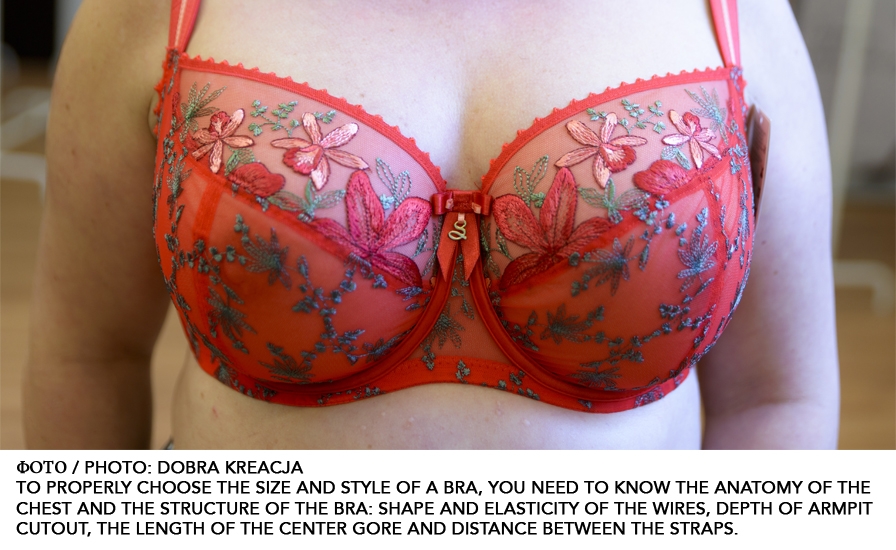
BRA FITTING:
HEALTH AND COMFORT
Since that moment, during bra fitting
sessions I began to learn from clients where they felt pain or
discomfort while wearing lingerie. It turned out that the most painful
area is directly under the mammary glands as well as in the armpits,
where the underwire ends. I sought to better understand the cause by
paying particular attention to where the wires and band are located and
the force of their pressure, and, if the clients complained of
discomfort, I asked when this discomfort arose: when they sat quietly or
moved actively?I realized that it was necessary to develop new methods
for choosing and adjusting bras that should be implemented during the
bra fitting process, and I began to deepen my knowledge simultaneously
in three directions. First, I observed the structure of the chest and
studied its characteristics: the structure of the ribs, sternum and
shoulders, the height of the mammary glands and the distance between
them. Secondly, I began to take into account the client's breathing and
the changes in chest volume when inhaling and exhaling. Finally, I began
to study the anatomy of the breast and the structure of the lymphatic
system in the thorax.
I wrote an article about the first two concentrations of my research,
published in the February 2018 issue of Intimoda, and now I would like
to share more about the critical third point.

ANATOMY LESSON
The structure of the mammary gland
Did you
know that the Latin name for the mammary gland – glandula mammaria –
also gave its nomenclature to a whole class of vertebrates: mammals
(Latin: Mammalia)? The mammary glands are situated symmetrically on the
front wall of the chest between the third and sixth or seventh pair of
ribs. The distance between them depends on individual structure. Most of
the mammary gland is located on the pectoralis major, and only a minor
lateral part is situated on the serratus anterior muscle (Bochenek A.,
Reicher M. Gruczoł sutkowy, Anatomia człowieka, T V. PZWL 2008).The
breast is located under the clavicle, limited medially by the edge of
the sternum, and limited laterally by the middle axillary line.
In the picture you can see that the mammary gland consists of three
types of tissue: glandular, located primarily in the areola and nipple,
connective and fatty tissues (subcutaneous fat and fatty tissue located
behind the gland and between the lobes). The volume of these tissues
varies from one individual to the next, therefore, doctors distinguish
between two types of breasts: those with predominantly fatty tissue or
predominantly glandular tissue. According to studies, the ratio of these
tissues in humans is genetically determined and only varies slightly
based on hormones or aging. This is why understanding physiological
changes and individual client needs are so informative to the process of
choosing of a bra.
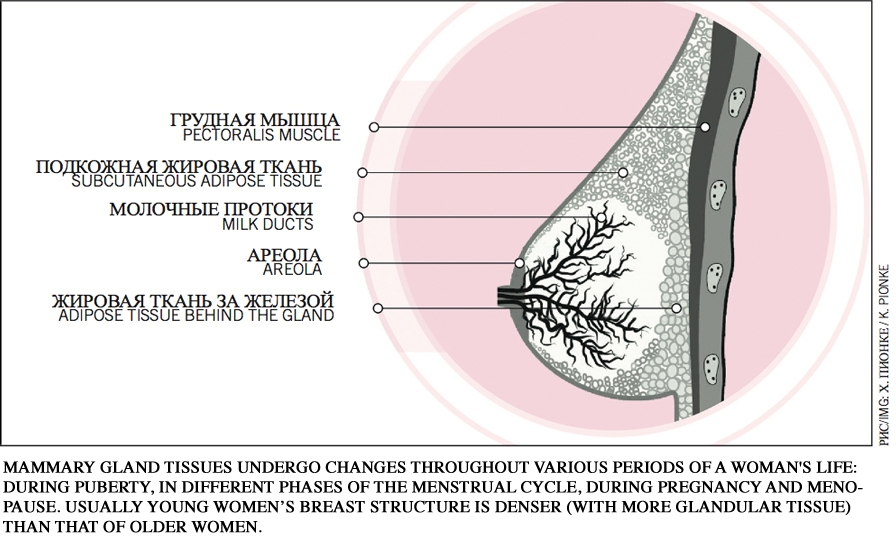
The mammary glands are permeated with lymph (a fluid that travels through the lymphatic system’s channels carrying cells to help the body fight infections) and a network of blood vessels (veins and arteries), and the sensory nerve terminals are located within the skin of the thorax and armpits. This causes an increased reaction to any agents in these areas, including any interaction between the surface of the bra and the body: for example, pressure or friction as a result of movement of material or the bra itself. In this context, when dealing with clients, it is necessary to explain the relationship between, for example, a cup that’s too small and the resulting discomfort or pain in the armpit area.
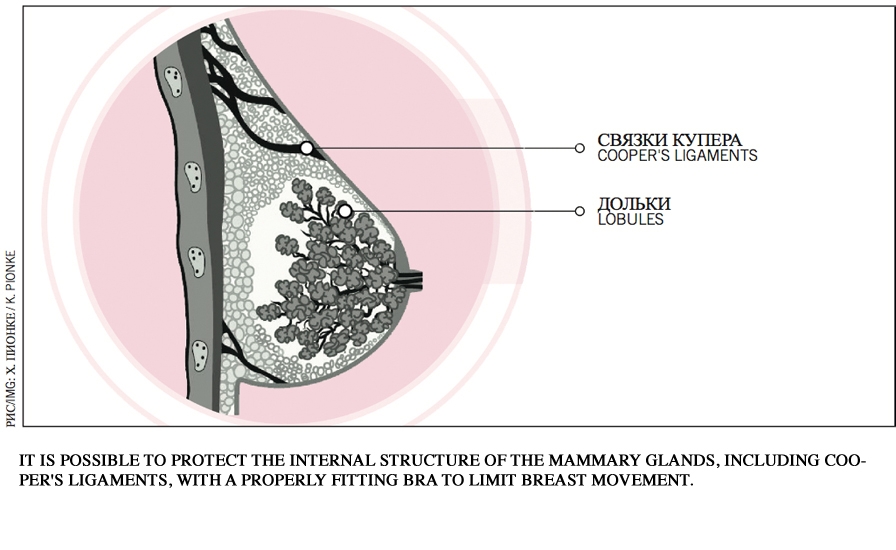
Why does the breast have this shape?
The mammary glands have a
semicircular or conical shape, and function as a paired organ: the
body’s largest cutaneous gland. As the mammary glands do not have
muscles, but rather overly the pectoralis major muscles, they are
naturally held in place by skin, ligaments and fasciae consisting of
dense connective tissue. The field of study in the structure of the
breast is quite young, however I would like to pay attention to two
significant events related to it.
The first is the classification of Cooper’s ligaments in 1840. The name
comes from the author of their discovery – Astley Cooper. Cooper’s
ligaments are connective strips of fibrous tissue that support the
breast from above and below and lift it up, thereby helping it to
maintain structural integrity. They reach from the skin through the
mammary glands to the edge of the pectoral muscle.
According to a study by Dr. Joanna Scurr of the University of Portsmouth
in the United Kingdom, the strength of these ligaments weakens by 65%
in women over 45 years, and the elasticity by 40% compared to younger
women.

The second event, and one of the latest developments in the field of research on the structure of the breast, is the discovery in 1996 of horizontal and lateral supporting ligaments by the German plastic surgeon Elizabeth Würinger. Würinger’s ligaments are strong connective tissue that hold the mammary glands in a suspensory U-like cradle and support the entire structure of the gland (source: https://clinicalgate.com/the-central-septum-in-breast- reduction-and-mastopexy/ 28.06.2018). The research of Joanna Scurr (2009) in the field of breast biomechanics has shown that the mammary gland extends in three directions, with only 44% of movement occurring vertically. To prevent ligament sprains, improve breast health and reduce the risk of sagging, the mammary gland must be properly supported by stabilizing the bra band and choosing the right cup size so that it completely covers the mammary gland. The mammary glands require support and further adjustment of the bra at every life event that can affect breast size: puberty, pregnancy, breast feeding, menopause, weight changes, sports, physical work, and aging.
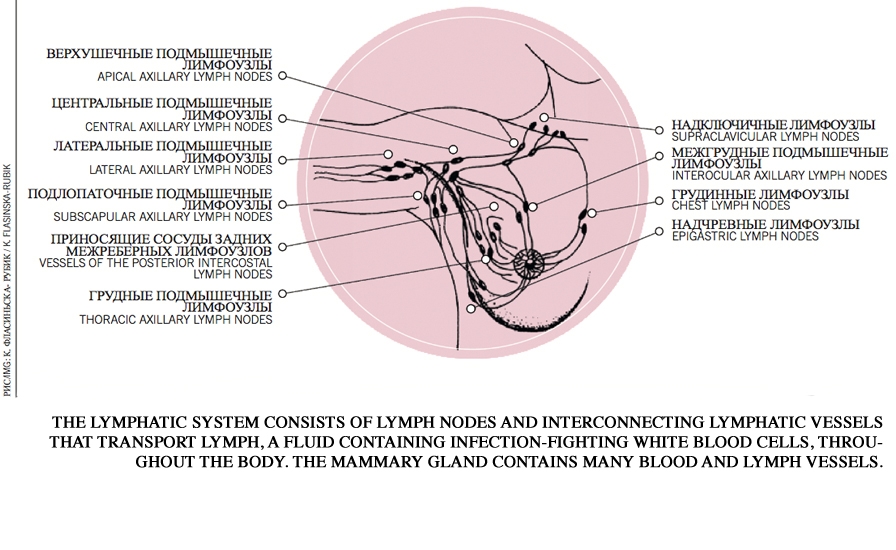
Lymphatic system
The lymphatic system covers the entire body. If you look at the
positioning of the lymphatic system in the chest, you can see that bra
straps, underwires and band are situated precisely in those areas where
the lymphatic vessels and lymph nodes pass (apical axillary, subscapular
axillary, breast, supraclavicular and epigastric).The lymph nodes are
located along the efferent lymphatic vessels. They are shaped like a
bean and range in size from 2 to 20 mm. They play a crucial role in the
normal functioning of the immune system: removing bacteria, viruses and
fungi, and collecting lymph with lymphatic vessels.
Lymph flows in the lymphatic vessels, which means if too much external
pressure is exerted upon them, edemas and even cysts may occur in this
area as a result of trauma or incorrect movement of the tissue fluid.
It is interesting to note that the more I speak with clients about the
structure of the breast and the location of the lymph nodes, and the
more I share this knowledge with them and explain the effect that an
improper choice of a bra has on their health, the more I see that such
sincere communication supports mutual trust and helps build our
relationship. In addition, I also obtain useful information; for
example, they are more likely to share with me what causes them
discomfort when wearing a bra, or the most important elements that they
look for in a bra.
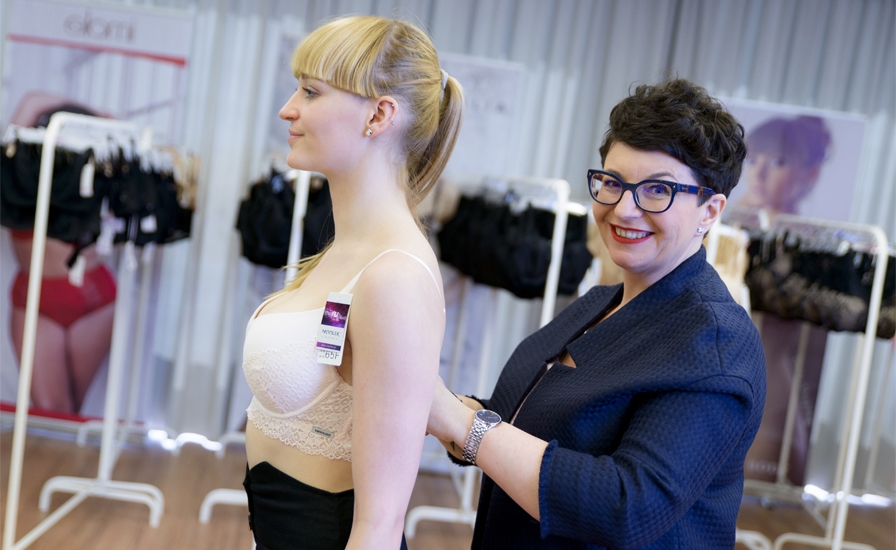
When conducting a bra fitting, I am able to identify specific and common
pitfalls. Delay of lymph movement, based on prolonged compression of
the lymphatic vessels or lymph nodes in the mammary gland, can occur due
to:
• improper adjustment of the bra band: it slips if it is
too loose, and compresses if it is too tight,
• incorrect selection of the underwire shape: too wide
or too narrow for the anatomical form of the breast,
• wire pressure
on the breast tissue
or friction in the axillary area,
• incorrect cup size: too small or
too large, which also leads to excessive pressure from underwire, straps
and bra band on the mammary glands and the area under them,
• incorrect placement of the bra’s center gore: too high or causing too much pressure,
• incorrect bra wearing.

FIVE METHODS FOR CORRECTLY SELECTING A BRA
1
Check the band fitting. If it is placed too low, it will descend to the
diaphragm, the main respiratory muscle, and can weaken its work,
negatively affecting the functioning of the respiratory system and
circulatory systems.
2 Train the client to move her
breast tissue into the bra cup by scooping gently from the outermost
side. Then the wires will be placed
around the breast and it is safe to say that the cup size and wire shape
fit correctly. If the cup is too small or large, or if the style does
not fit the figure, the wires will dig into the body, exerting constant
pressure on the mammary gland and other parts of the body, which can
cause pain.
3 Verify that the space at the base of the chest
between the wire and the edge line of the breast is full. If an empty
space remains, move the wire up,
directly to the base of the mammary gland. This is important in order to
avoid excessive squeezing of the epigastric lymph nodes and other
organs of the abdominal cavity that can create discomfort.
4
Check in three positions to ensure that the wires are correctly
positioned: stand directly in front of the mirror, then turn first to
the right side and raise
the right arm, turning next to the left side with the left arm raised.
These three points of view allow you to check bra positioning against
the respective mammary glands. In the case of an asymmetrical breast,
the wire of the larger mammary gland will point forward, and on the
smaller one, the wire will point back. Choose the style with optimal
position of the wires around the edge line on both sides of the mammary
glands.
5 Explain to the client that the bra straps,
positioned on the same line as their attachment to the cup, reduce
pressure on the
sternocleidomastoid and trapezius muscles. Thus, you can evade muscle
pain, which occurs as a consequence of the disturbance of blood
circulation, and discomfort when turning the head and neck in various
directions.
Knowing the structure of the mammary glands and understanding the
functions of the lymph nodes will help the client to better understand
the effects that her bra has on these sensitive areas and to appreciate
the relationship between a correct choice of bra and personal health.
When the client understands the reasons behind choosing a different
style or bra size, she is extremely willing to listen to our opinion. It
is also important to talk about the positive outcome of such a choice:
bra discomfort will disappear, which not only makes the woman feel
better, but also directly benefits her health.
www.DobraKreacja.pl facebook.com/DobraKreacja
ABOUT KATARZYNA SALATA
She has been working in the lingerie
industry since 2006, and in 2013 she founded the international
independent consulting company Dobra Kreacja. Katarzyna Salata provides
advice to lingerie companies’ teams of designers and their internal
design studios. She was the first in the bra fitting industry to take
into account the individual anatomical features of the chest when
choosing a bra. She is an expert in the field of bra construction,
adjustments and sales, she conducts trainings for manufacturers,
wholesalers and stores’ sales assistants in Poland and abroad. She
provides active assistance to the Amazons (women who have undergone
breast surgery), and conducts professional master-classes in bra fitting
(International Brafitting MasterClass), as well as individual seminars
for lingerie stores.
Copyright 2025. All rights reserved - Terms






